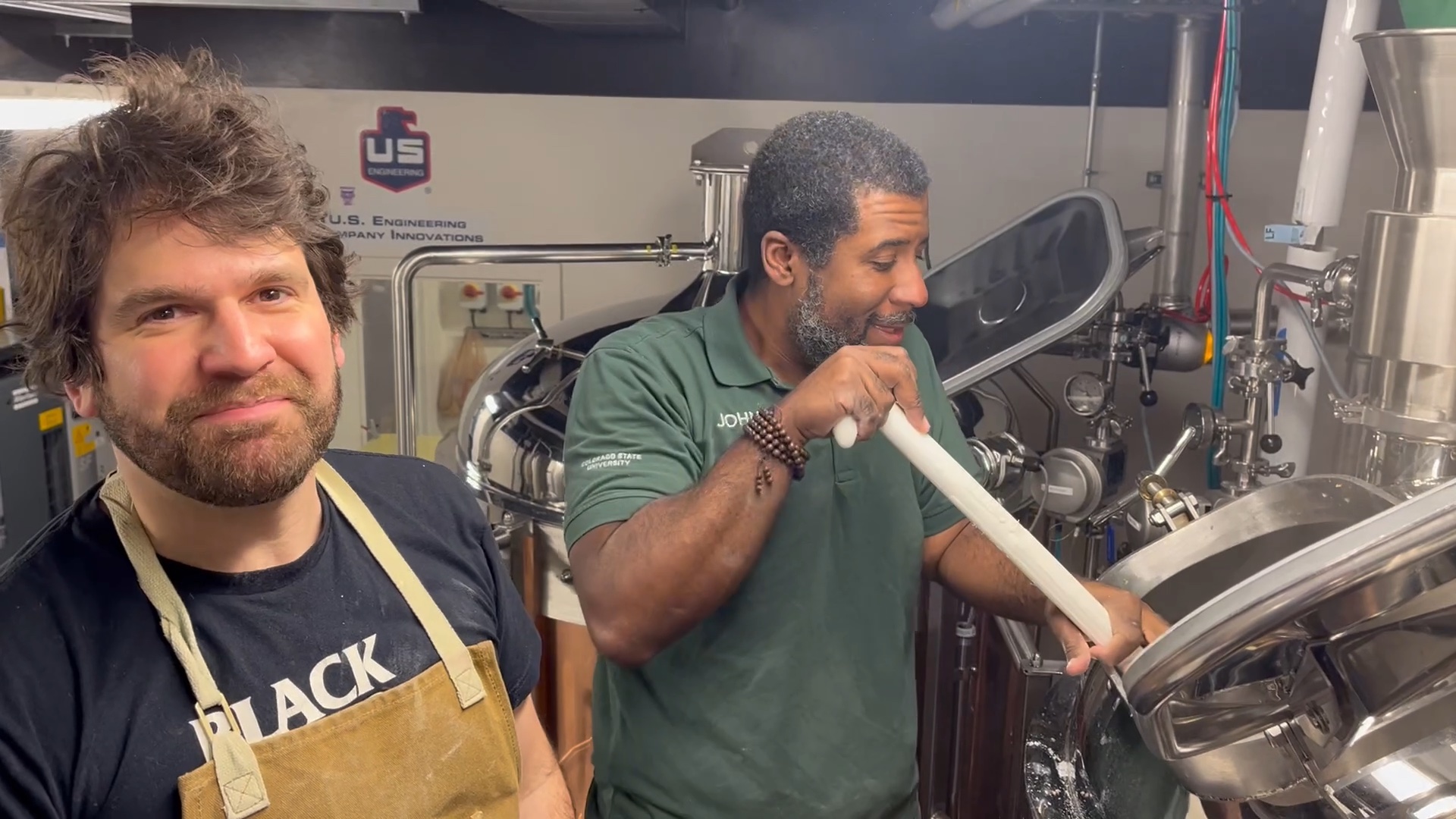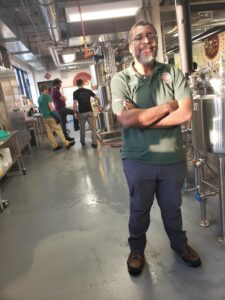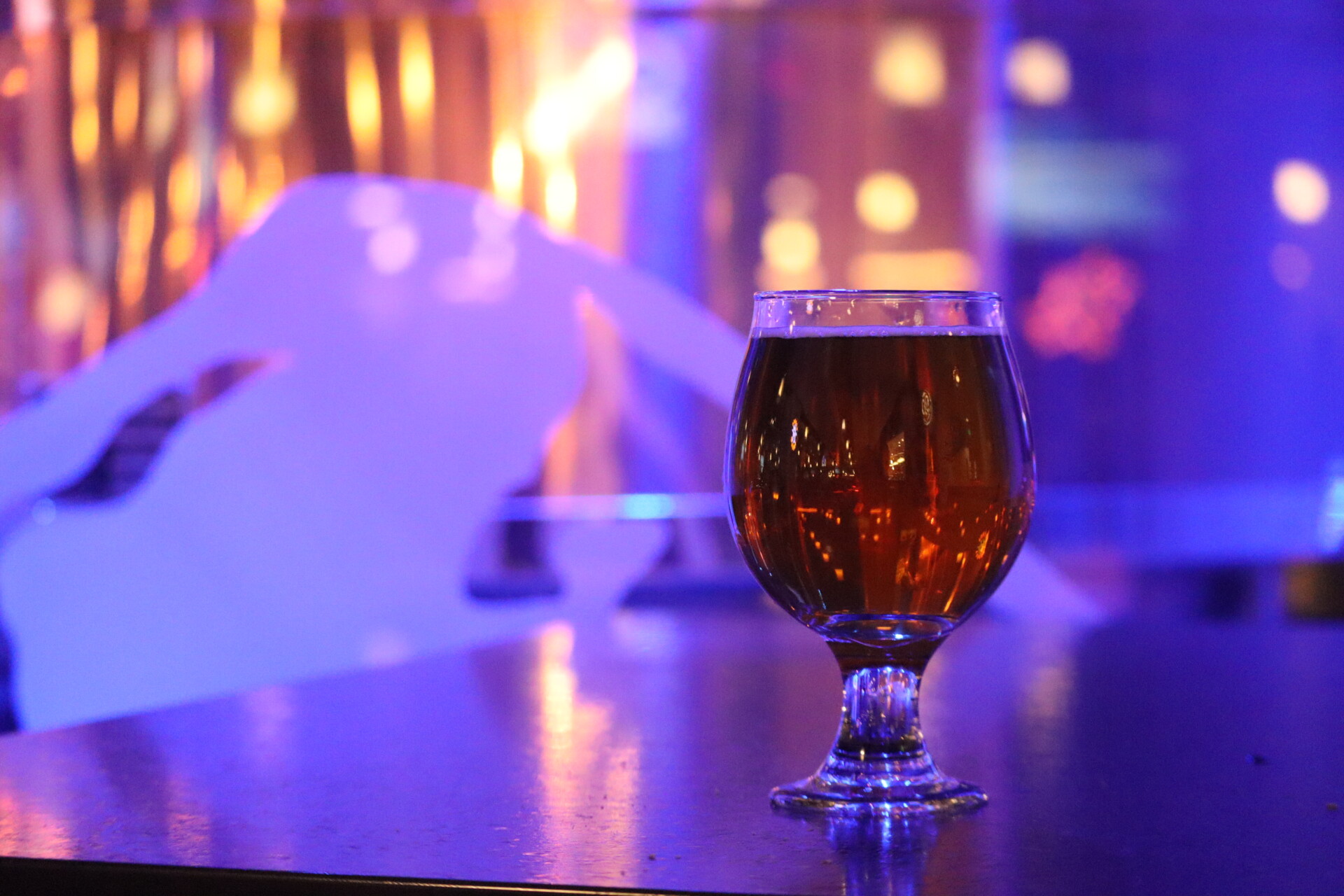
There is a revolutionary new beer on tap at the Ramskeller, and its flavor profile is as diverse and remarkable as the culture it was crafted to represent.
SUN RAm, a spiced, strong brown ale with floral notes and flavors of honey and molasses, is the product of collaborative efforts among the Black/African American Cultural Center, the Department of Food Science and Human Nutrition, an associate professor of art and Fermentation Science and Technology students and staff. It was brewed to celebrate Black culture and to mark Black History Month at CSU, which is being called Black Destiny Month this year.
The new brew is the first beer born at CSU as the result of this type of interdepartmental cooperation, and the meeting of minds – or of tastes – has given rise to something special.
“It’s a darker brew,” said B/AACC Director Duan Ruff. “But not so heavy. It takes you on a journey with its notes of sweetness and spice.”
A cooperative venture like this, intended to inspire new cultural connections and provide aspirational opportunities for students of color, has been on the mind of John Wilson, assistant professor in the Department of Food Science and Human Nutrition, for several years. Brewing plays a vital role in Black history, and with renewed interest in the craft within the community, Wilson hoped to find a collaborative connection on campus for the project.
He reached out to all the cultural centers on campus, and when Ruff and the B/AACC voiced interest, Wilson got to work.
First, he and Ruff facilitated a brainstorming session in late September with B/AACC students to identify aspects of their individual experiences and identities that might translate into flavors, spices and aromas for the beer. Students offered shared principles to help characterize the new brew, such as leading by example, celebrating strengths and working toward a revolutionary future, a goal of the B/AACC community.
Sensory words also tumbled out around the table: colorful, joyful, free, tropical, spicy and cozy.
“I love the smell of baked apple pie,” offered one. “Oh, sweet potato pie,” said another, “and peach cobbler!”
Wilson took these ideas back to his lab at Gifford, and with the help of other FSHN faculty and Ruff, devised parameters for a statewide contest for homebrewers to design and produce a recipe that embodied those values and tastes.
“To make a ferment for somebody is an act of love,” said Wilson, who grew up brewing and distilling with his father. “To consume a ferment, it’s an act of trust. This cycle of love and trust is how communities hold together over time.”

A hectoliter of intuition and experience
Across campus early in November 2023, avid homebrewer and Associate Professor of Art and Art History Johnny Plastini got word of the competition.
“I have a passion for creating rustic and experimental ales with unique conceptual backing, so this call for entry resonated with my ethos and commitment to craft beer,” he said.
With little more than a month to brew a 10-gallon prototype batch and to deliver sample bottles to the judges, and no time to test and sample various recipes, Plastini said he relied on his intuition and experience, and placed trust in the process as the experimental brew developed.
“Rather than honing in on one specific flavor or aroma profile, I decided to create a beer that is unexpected and adventurous in flavors and aromas by encouraging diverse interactions that mingle in concert with each other,” he said. “I wanted to create a beer that seemed both ancient and futuristic.”
Plastini, who also works as the area coordinator of printmaking in his department, said creating the beer was much like creating an art piece.
“When crafting a new beer recipe, I try to think of it like an artist drawing a sketch prior to making a finished work of art. There is planning beforehand, but I try to let the ingredients and processes of brewing inform me every step along the way,” he said.
Primarily using locally sourced malted barley and rye from Troubadour Maltings in Fort Collins and Root Shoot Malting in Loveland, Plastini enhanced his recipe with obscure varieties of South African hops. He also used a unique farmhouse ale yeast, which ferments at high temperatures and produces an abundance of tropical, fruity flavors and aromas, allowing for the addition of stronger herbs and spices to bolster the flavor profile.
“Some ancient biblical healing herbs such as hyssop, yarrow and Angelica root were added to this brew, then strained out prior to fermentation so that their songs could be heard in the background as a chorus in support of the more dominant fruity and tropical flavors,” Plastini said. “We also contributed a small addition of blackstrap molasses to the brew prior to fermentation, which contributes flavor, color and extra fermentable nutrients for the yeast.”
“I named the beer ‘SUN RAm’ to pay homage to the black musician Sun Ra, while also recognizing the ‘ram’ as mascot at CSU,” he said.

Scaling up the recipe
Plastini’s flavor profile stood out among other entries. His beer was awarded first place by the FST faculty and staff, and also was the choice of the B/AACC tasters in a blind evaluation. Jeff Biegert, CSU’s brewmaster and New Belgian Brewery sponsored FST instructor, said he was impressed by how “spot on” the home brewer’s entry was.
“It was such a unique beer,” Biegert said. “He did such a great job of integrating so many distinctive ingredients that exemplify the diverse aspects of the Black community.”
The next challenge, Biegert said, was scaling up the recipe – going from 10 gallons to 1,000 liters (about 270 gallons) while keeping the flavor profile intact. Biegert, a professional brewer for more than 31 years, applied his knowledge of brewing science and materials as the team moved toward an early January 2024 production.
Biegert manages and operates two breweries on campus, the Gifford Brew Kitchen at the Gifford Building and the Ramskeller Brewery at the Lory Student Center. He teaches two 400-level Brewing Science classes in the FST degree program that focus on the brewing process, including the math and science that is crucial to scaling up a recipe for production.
“You also have to understand the raw materials – rye, malted barley, specialty grains, spices, hops and yeast – and how they react during fermentation. Everything from sourcing raw materials, understanding how to manage and control color, alcohol content and even water chemistry,” he said, “all stuff I teach in the FST curriculum.

“It’s not as easy as multiplying the original recipe,” Biegert continued. “Spices can be kind of a tricky thing, and we had to make slight changes to the hop recipe. Still, on brew day, it turned out really well.”
Preparations started in early December of 2023, and brew day was Jan. 10 at the Ramskeller Brewery. Wilson, Plastini, Biegert and several students in brewing science classes were on hand to participate in the brewing process, which took about nine hours to complete.
“During this time, all the raw materials are processed. Then we cool the resulting sweet sugary liquid, called wort, before we add yeast to it,” Biegert said. “This beer took about a week to ferment, and another one to two weeks to mature. Once it was ready, we moved the beer to a separate tank for carbonation and packaging into kegs.”
SUN RAm, which has an alcohol content of 7%, will be available for those of legal age as long as supplies last at the Ramskeller Pub. Fermentation students are also working on an alcohol-free soda for the celebration.
There are three additional beers on tap at Ramskeller Pub that were brewed by fermentation staff and students: Cam’s Orange, a Belgian wheat; Campus Crampus, a strong English-style beer; The Dark Crystal, a hoppy amber; and FNA, a Belgian Saison.
Impact beyond great taste
For Wilson, the ongoing significance of this collaboration is powerful, especially during Black History Month celebrations.
“Traditionally, the craft beer industry has excluded people of color – they couldn’t operate as freely and were shut down by authorities more often,” he said, adding that both his grandfather and great-grandfather were brewers/bootleggers. “When Prohibition was repealed, the only brewers left were of German ancestry – that’s why we have the big German breweries now. Right now, however, there’s a rise of people of color in brewing.”
Wilson said he hopes that as people enjoy SUN RAm, they consider the story behind it, and all the people who worked together for months to bring the new brew to the Ramskeller Pub.
“I hope they think about where the inspiration came from, and what it represents, because you can learn a lot about a community by sharing stories that they tie to flavors and aromas,” Wilson said. “It’s super cool!”
For Ruff and the B/AACC community, the beer’s impact lies in making connections and finding new areas for growth. Proceeds from the sale of SUN RAm also will help fund programming at the cultural center.
“There’s a larger picture here, and it’s creating waves of connection – with Black History Month and Fermentation Science. So, through this interest in Black brewing communities, an interest grows in Black history, and possibly a connection between people,” Ruff said.
“Sometimes you make connections instead of waiting for them. Hopefully we get Black brewers and Black students to contribute to what the industry can become in future years,” he said.
Plastini said he hopes this beer encourages everyone to pause for a moment to consider social healing and cultural sustainability as tasks that are never fully finished.
“I hope that when someone holds up a glass of SUN RAm, they are considering that liquid as a living culture capable of merging the past, present and future through a multisensorial experience,” he said.